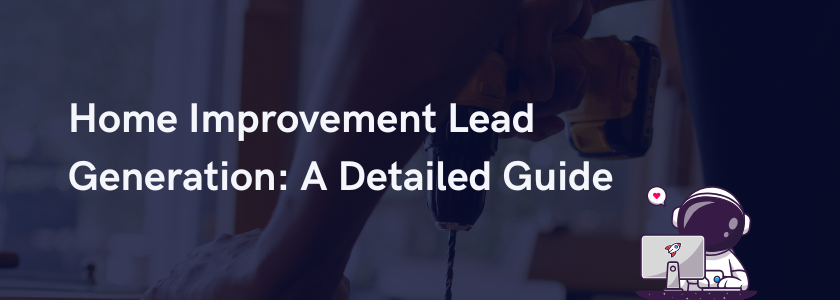In the competitive world of home improvement, having strong skills and a great reputation isn’t always enough. If you want your business to grow, you need a steady stream of new projects — and that starts with effective home improvement lead generation.
Many contractors face the challenge of attracting leads and making sure they are the right kind. Random inquiries that go nowhere can drain your time and energy. Real success comes from connecting with homeowners who genuinely need your services and are ready to move forward.
In this detailed guide, we’ll walk you through practical strategies to generate home improvement leads consistently. You’ll learn which methods work today, how to set up smart systems to attract more clients, and why choosing the right home improvement lead generation services agency can make a big difference.
What Are Home Improvement Lead Generation Services?
Home improvement lead generation services are companies that specialize in finding homeowners who need projects completed. They typically gather leads through websites, advertising campaigns, or partnerships, then connect those leads to contractors in specific service areas.
Some services offer leads that are shared among multiple contractors. Others focus on exclusive leads, where the homeowner’s information is only sent to you. Choosing the right type depends on your business goals, budget, and how much competition you’re willing to manage.
The right service should help you generate home improvement leads consistently while saving you time on marketing and prospecting.
Why Home Improvement Lead Generation Matters
Growing a home improvement business is tied closely to how well you manage your home improvement lead generation efforts. No matter how good your services are, it’s difficult to stay busy without a strong system for bringing in new clients.
The truth is that most homeowners don’t randomly hire the first company they find. They often request quotes from several contractors, read reviews, and compare offers before making a decision.
If you are not actively working to generate home improvement leads, you risk being overlooked even if you offer better quality than your competitors.
Home improvement lead generation is also important for keeping your schedule full year-round. Many contractors experience slow seasons because they rely only on referrals or repeat customers.
While these are valuable, they are often not enough to maintain steady business growth. Consistent lead generation ensures that you have new prospects coming in regardless of the season.
Another point to consider is the quality of the leads for home improvement. Not every inquiry will turn into a project. That’s why having a structured home improvement lead generation system helps you focus your time on real opportunities instead of chasing unqualified leads.
Building the right strategy can also make your marketing budget work harder. Instead of spending on broad advertisements that reach people who aren’t ready to hire, a smart approach to home improvement lead generation helps you target those who are actively seeking services.
Understanding the Basics: How to Generate Home Improvement Leads
Before exploring complex strategies, it’s important to grasp the basics of generating home improvement leads.
At its core, lead generation means finding ways to attract homeowners who are interested in hiring a contractor for their project, and encouraging them to contact you.
In the past, word-of-mouth referrals, local newspaper ads, and yard signs were enough to keep many businesses running. These methods still have value today, but they need to be paired with digital efforts if you want to consistently generate home improvement leads.
A good lead generation strategy usually includes three parts:
- Awareness – Getting your business in front of homeowners when they start thinking about a project.
- Engagement – Providing valuable information or an easy way for them to learn more about your services.
- Conversion – Making it easy for them to reach out to you or request a quote.
The key to successful home improvement lead generation is making sure you’re visible when people are actively searching for help. Homeowners today often use search engines, social media, and review sites when deciding who to hire.
If you’re not showing up there, you’re missing a large portion of potential leads for home improvement.
Effective Digital Strategies to Generate Home Improvement Leads
Modern homeowners spend a lot of time online, which makes digital marketing one of the best ways to generate home improvement leads today.
If you want to reach people where they are already searching, you need to be active across several digital channels.
1. Search Engine Optimization (SEO)
Search Engine Optimization (SEO) is one of the most reliable ways to generate home improvement leads. When a homeowner types in “bathroom remodeling near me” or “roof replacement services,” your goal is to be one of the first businesses they see.
Good SEO focuses on several factors. You want to make sure your website is fast, mobile-friendly, and easy to navigate. Each service you offer should have its own clear page with specific keywords related to your work. For example, using phrases like “kitchen renovation contractor” or “window installation services” within the content helps search engines match your site to user searches.
Blogging also plays a big role in home improvement lead generation. When you post helpful articles answering common homeowner questions, you not only build authority but also attract new visitors. Over time, strong SEO helps generate leads for home improvement consistently without needing to spend on ads for every new inquiry.
2. Paid Advertising (Google Ads and Facebook Ads)
If you are wondering how to generate home improvement leads quickly, paid advertising is a proven method. Google Ads allow you to target people actively searching for specific services, while Facebook Ads help you reach homeowners based on interests and location.
A well-managed paid advertising campaign can help you generate home improvement leads without having to wait months for organic results. However, it’s important to track each campaign carefully to avoid wasting money on clicks that don’t turn into projects.
3. Local Search Optimization
Local visibility is critical for strong home improvement lead generation. Claiming and optimizing your Google Business Profile helps your business appear in local map results, especially for searches like “roof repair near me” or “home renovation contractor in [your city].“
Keeping your profile updated with accurate service descriptions, business hours, and real project photos makes it easier for homeowners to trust you. Positive reviews also boost your chances of capturing leads for home improvement directly through local search.
Listings on other platforms, such as Yelp, Angi, and Houzz, can also help generate home improvement leads within your service area. The easier you are to find locally, the more inquiries you will receive.
4. Content Marketing
Content marketing involves creating useful and educational materials that help homeowners before they hire a contractor. This could be blog articles, project guides, infographics, or even videos showing project walk-throughs.
When you publish content that answers common questions, such as “How much does a kitchen remodel cost?” or “When is the best time to replace windows?” — you position your company as a knowledgeable and trustworthy choice.
Content marketing attract random visitors and homeowners who are already thinking about their projects, making it a powerful way to generate home improvement leads.
Over time, content marketing becomes a steady source of leads for home improvement, helping your business grow without depending solely on paid ads.
5. Email Marketing and Lead Nurturing
Sometimes, homeowners are interested in a project but aren’t ready to commit right away. That’s where email marketing comes in. Capturing their email address through your website—through a free quote form, for example—allows you to stay connected.
Sending helpful updates, seasonal promotions, project ideas, and homeowner tips keeps you engaged with potential clients. Even if homeowners aren’t ready to start right away, consistent communication builds trust. When they’re finally ready to start their project, you’re more likely to be the first company they call.
A good email nurturing strategy doesn’t pressure homeowners. Instead, it provides value over time and gently reminds them about your services.
6. Retargeting Campaigns
Not every homeowner will contact you the first time they visit your website. Retargeting is a smart tactic if you want to generate home improvement leads from people who already showed interest but didn’t take action the first time.
Using tools like Google Display Network and Facebook retargeting ads, you can show ads specifically to people who have already visited your site. Maybe they viewed your “kitchen remodeling” page but didn’t reach out. Retargeting ads would remind them of your business while they browse other websites or social media.
Retargeting is a cost-effective way to generate home improvement leads because you’re advertising to people who have already shown interest. A second or third reminder is often what nudges them into making that first call.
Tried-and-True Traditional Methods That Still Work
While digital marketing dominates today’s strategies for home improvement lead generation, traditional methods still have an important place. In many communities, especially suburban and rural areas, homeowners continue to respond well to more personal and direct forms of outreach.
If you’re looking for a well-rounded approach, combining digital efforts with proven traditional tactics can help you generate home improvement leads more effectively.
1. Direct Mail Campaigns
Direct mail may seem old-fashioned, but it remains a surprisingly effective way to generate home improvement leads, especially for local projects.
Sending professionally designed postcards, flyers, or newsletters to homeowners in your service area keeps your company top of mind. Well-targeted campaigns can yield strong results, like sending offers to neighborhoods with aging homes or recent real estate sales.
Including a clear call-to-action like “Schedule a Free Consultation” or “Get a Free Estimate” encourages immediate response. If you’re wondering how to generate home improvement leads without heavy online competition, direct mail can still be a smart investment.
2. Home Shows and Expos
Home shows, renovation expos, and local trade fairs attract homeowners who are already thinking about projects. Having a booth or display at these events gives you the chance to showcase your work, meet potential clients face-to-face, and build relationships.
People who attend these shows are often serious about their plans. Gathering contact information, handing out brochures, and offering small giveaways can generate home improvement leads that are more engaged and ready to move forward compared to cold online inquiries.
Plus, face-to-face conversations allow you to build trust much faster than digital ads or emails.
3. Building Referral Networks
Word-of-mouth remains one of the strongest ways to get new leads for home improvement. Satisfied clients are often happy to recommend a contractor they trust, especially if you make it easy for them.
Encourage referrals by offering a small thank-you gift, discount, or referral bonus to past clients who refer new customers to you. A simple email or handwritten thank-you note after project completion can gently remind homeowners that you appreciate referrals.
Beyond clients, building partnerships with real estate agents, interior designers, architects, and even hardware store managers can also lead to steady referrals. These professionals regularly meet homeowners in need of contractors, giving you another channel to generate home improvement leads naturally.
4. Yard Signs and Vehicle Branding
Visible proof of your work is a powerful marketing tool. After completing a project, asking homeowners if you can leave a yard sign for a few weeks can attract attention from neighbors who might be planning similar upgrades.
Vehicle wraps or branded magnets on your company vehicles turn every service call into a marketing opportunity. When you park outside a client’s home, you show the whole neighborhood who is trusted enough to do work there.
Over time, simple visibility tactics like these can generate home improvement leads without ongoing advertising costs.
Top Mistakes to Avoid in Home Improvement Lead Generation
Many contractors put time and money into home improvement lead generation efforts, but don’t see the results they expect because of avoidable mistakes.
Knowing what to watch out for can save you from wasted budgets, missed opportunities, and unnecessary frustration.
Here are some of the most common mistakes that can slow down your ability to generate home improvement leads:
1. Paying for Low-Quality Leads Without a Screening Process
It’s tempting to partner with any service that promises a high volume of leads for home improvement, but not all leads are equal. Some companies focus on quantity over quality, passing along contacts who may have little real intent to hire.
If you want to generate home improvement leads that actually turn into projects, always ask potential partners how they source and qualify their leads. It’s better to pay for fewer, high-quality opportunities than chase dozens of unqualified inquiries that waste your time.
2. Ignoring the Importance of Speed in Follow-Ups
When a homeowner submits an inquiry, they often reach out to several contractors at once. If you wait hours—or worse, days—to respond, you’ve probably already lost the opportunity.
Quick, professional follow-up is critical to success in home improvement lead generation. Aim to call, email, or text back within minutes whenever possible. A fast, polite response shows that you are serious, attentive, and respectful of the homeowner’s time—traits that homeowners value highly.
3. Over-Relying on a Single Lead Source
Even if a particular channel is working well today, putting all your trust in one lead source is risky. Algorithms change. Platforms get more expensive. Markets shift.
A smart home improvement lead generation strategy spreads risk across multiple sources: SEO, paid ads, referrals, traditional marketing, and possibly home improvement lead generation services.
When you diversify, you protect your business from sudden drops in lead volume if one channel slows down.
4. Not Tracking or Measuring Lead Performance
If you don’t track which leads convert into projects and which ones don’t, you’re guessing rather than managing. Without clear data, it’s easy to keep pouring money into sources that aren’t delivering a real return.
Tracking metrics like cost per lead, cost per acquisition, and lead-to-close rate helps you understand where your marketing dollars are most effective. This level of insight is essential to refining your home improvement lead generation efforts over time.
5. Forgetting to Nurture Warm Leads
Not every homeowner is ready to start immediately. Some are gathering ideas, budgeting, or waiting for the right time. If you forget about these “warm” leads after the first contact, you could be missing out on future business.
Creating a simple nurturing system, like a few follow-up emails or check-ins, helps keep your business top of mind. When they are ready, they’ll be more likely to reach out to a company that stayed in touch rather than start the search all over again.
Proven Tips to Get More Qualified Leads for Home Improvement
Generating a steady stream of leads is important, but quality matters even more. Chasing too many unqualified inquiries can waste your time and drain your marketing budget. Focusing on better-qualified prospects helps you book more jobs with less effort.
Here are proven strategies to help you generate home improvement leads that are more likely to convert into real projects:
1. Build Strong Landing Pages
Your website is often the first impression a homeowner will have of your business. If your landing pages aren’t clear, fast, and persuasive, potential clients might leave without reaching out.
When building pages designed for home improvement lead generation, focus on:
- Clear headlines explaining what you do
- Trust signals like awards, certifications, and customer reviews
- Simple, easy-to-find contact forms
- Strong calls-to-action like “Request a Free Quote” or “Schedule Your Consultation”
A well-designed landing page not only helps generate home improvement leads but ensures the leads you attract are serious about moving forward.
2. Use Forms That Are Short and Focused
It’s tempting to ask for a lot of information upfront, but long, complicated forms often scare people away. Focus on the basics: name, email, phone number, service needed, and preferred contact method.
You can always gather more details after the first point of contact. When you make it easy to inquire, you naturally generate more home improvement leads without adding unnecessary barriers.
3. Showcase Testimonials and Case Studies
Homeowners want to know they can trust you before hiring. Displaying real testimonials and detailed case studies from past clients builds credibility.
Good testimonials should include specifics — not just “great work,” but details about how you solved problems, stayed on schedule, or delivered high-quality results.
Including strong social proof can significantly increase your chances of converting leads for home improvement into paying clients.
4. Offer Free Consultations or Estimates
Homeowners are more likely to reach out if there’s no risk involved. Offering a free consultation or estimate lowers the barrier for potential clients to contact you.
Use the free consultation not just as a sales opportunity but as a way to educate homeowners. Giving them useful advice without immediate pressure builds trust and often leads to more closed deals down the line.
5. Create Downloadable Resources
Offering free resources like “The Ultimate Guide to Planning a Kitchen Remodel” or “Top 5 Things to Know Before Replacing Your Roof” can attract serious homeowners who are actively researching projects.
When people download a guide from your site, they provide their contact information, giving you a chance to nurture them into leads for home improvement over time.
6. Improve Your Google Business Profile
An optimized Google Business Profile helps you generate home improvement leads from local searchers. Make sure your profile is updated with:
- Accurate business information
- Professional photos of your work
- Positive reviews
- Regular posts about promotions, project highlights, or tips
Appearing prominently in Google’s local listings builds trust and brings in homeowners looking for contractors near them.
7. Respond Quickly and Personalize Your Communication
A fast response alone is good, but a fast and personalized response is even better. When replying to inquiries, reference specific details the homeowner shared, and show that you are paying attention.
Taking a few extra seconds to personalize your emails or calls helps you stand out and turns more initial conversations into scheduled appointments.
8. Focus on Building Long-Term Relationships
Even if a lead doesn’t book immediately, staying in touch can pay off. Homeowners often plan projects months—even years—in advance.
Set up a simple follow-up system with occasional check-in emails, holiday greetings, or project ideas. When they’re finally ready, you’ll be the first contractor they think of.
How to Track, Measure, and Optimize Your Lead Generation Efforts
Setting up strong home improvement lead generation strategies is important, but knowing how they perform is what turns good efforts into great results. Without tracking, measuring, and adjusting your approach, you’re operating in the dark.
Successful contractors treat home improvement lead generation like any other part of their business: something that needs regular evaluation and improvement.
Here’s how to do it properly:
1. Identify the Right KPIs (Key Performance Indicators)
Start by defining the metrics that really matter. The right KPIs for home improvement lead generation include:
- Cost per Lead (CPL): How much you spend to acquire each lead.
- Lead-to-Appointment Rate: How many leads actually schedule a meeting.
- Appointment-to-Sale Rate: How many appointments turn into signed projects.
- Cost per Acquisition (CPA): The total cost to land one paying customer.
- Close Rate: The percentage of leads that become paying clients.
Tracking these metrics gives you a clear picture of where your strongest leads for home improvement are coming from and where you may be wasting resources.
2. Set Up a CRM System
A Customer Relationship Management (CRM) system helps you organize, track, and follow up with leads. Even a simple CRM tool allows you to:
- Record every lead’s source.
- Log interactions (calls, emails, meetings).
- Schedule follow-ups.
- Track the movement from lead to customer.
If you’re serious about scaling your ability to generate home improvement leads, a CRM is not optional. It keeps everything organized and ensures no prospect falls through the cracks.
3. Track Lead Sources Separately
When you generate home improvement leads from different channels, such as SEO, paid ads, direct mail, or lead generation services, it’s crucial to tag them properly.
This way, you can see which channels produce the most leads and, more importantly, which ones produce the best leads. You might find that although one platform sends a lot of leads, another produces more jobs with less effort. That insight helps you prioritize spending where it counts.
4. Conduct Regular A/B Tests
Testing small changes over time can help you fine-tune your marketing. You might A/B test:
- Different headlines on your landing pages
- Two types of Facebook ads
- Two follow-up email templates
For home improvement lead generation, even small improvements can make a big difference over the course of a year. Testing ensures you are always learning and improving your messaging to convert more homeowners into clients.
5. Review and Adjust Monthly
Home improvement lead generation isn’t a “set it and forget it” process. Markets shift, competitors adjust, and homeowners’ expectations change.
Set time aside each month to review your performance metrics. Ask:
- Which campaigns or sources brought in the most leads?
- Which leads turned into booked projects?
- Was the cost per lead reasonable compared to the project value?
Make adjustments based on real results. Shifting budget, changing targeting strategies, or revising your messaging regularly helps keep your system healthy and competitive.
How Reach Digital Can Help You Generate Home Improvement Leads
At Reach Digital, we understand that successful home improvement lead generation isn’t about chasing random inquiries—it’s about building a steady, predictable flow of quality leads that turn into real projects.
We specialize in helping contractors, remodelers, and home improvement businesses generate home improvement leads that match their specific goals, service areas, and project types.
Whether you’re looking for kitchen renovation clients, roof replacements, or whole-home remodels, our team designs strategies tailored to your needs.
If you’re ready to build a smarter, more reliable lead generation system for your home improvement business, we’re here to help.
Learn more about Reach Digital and how our services can help you generate better home improvement leads today.





